Robot-assisted Surgical Systems Market Size
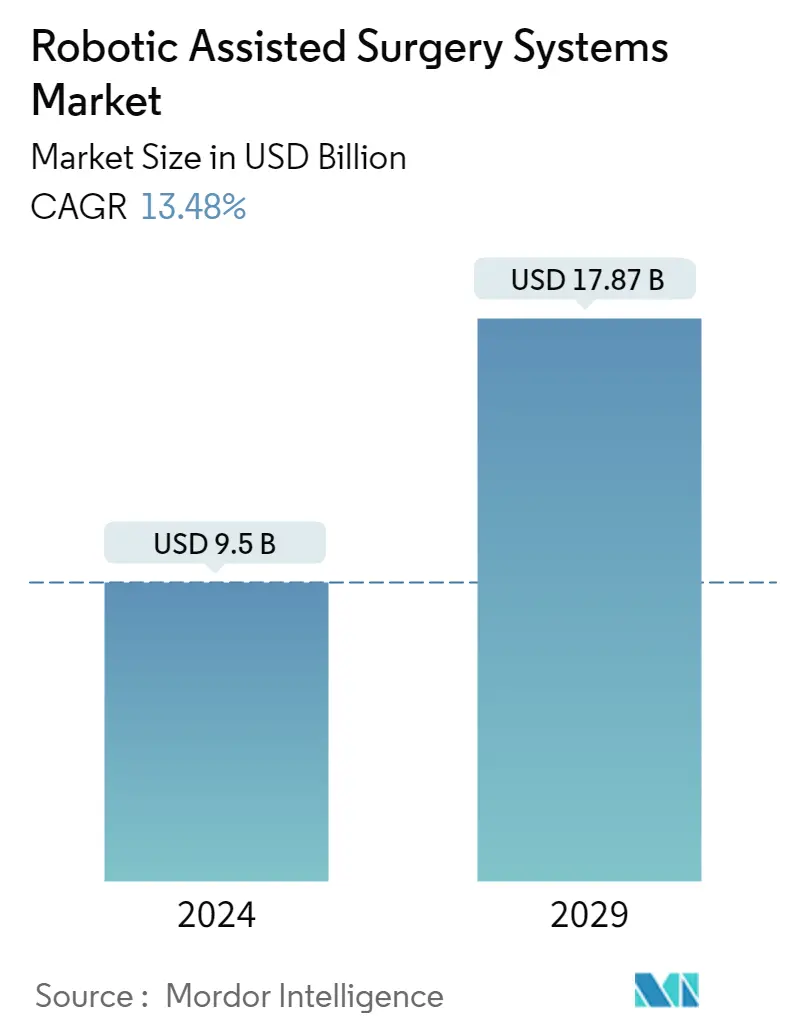
| Study Period | 2019 - 2029 |
| Market Size (2024) | USD 9.50 Billion |
| Market Size (2029) | USD 17.87 Billion |
| CAGR (2024 - 2029) | 13.48 % |
| Fastest Growing Market | North America |
| Largest Market | Asia Pacific |
Major Players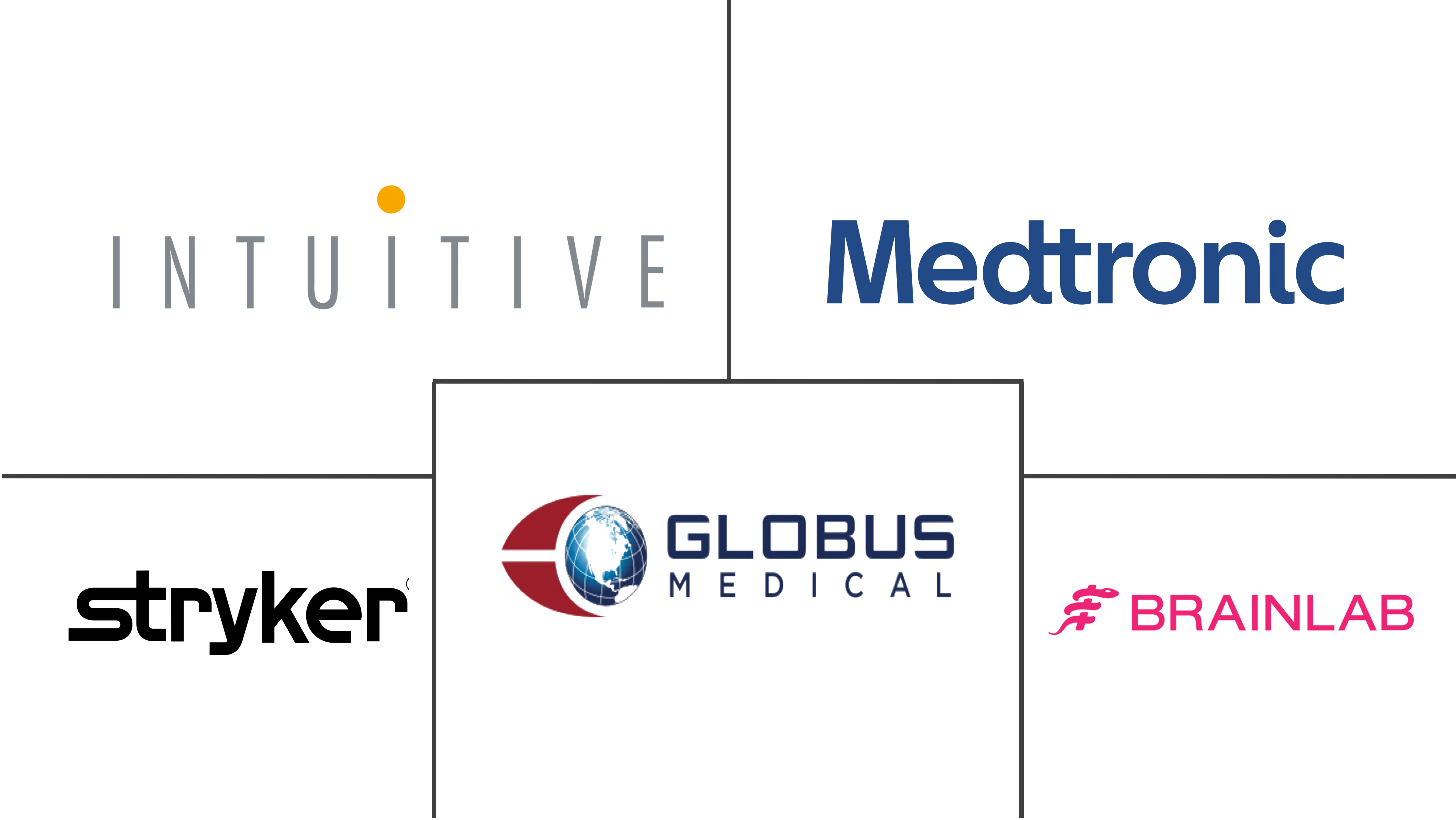
*Disclaimer: Major Players sorted in no particular order |
Robot-assisted Surgical Systems Market Analysis
The Robotic Assisted Surgery Systems Market size is estimated at USD 9.5 billion in 2024, and is expected to reach USD 17.87 billion by 2029, growing at a CAGR of 13.48% during the forecast period (2024-2029).
COVID-19 had a profound impact on the robotic-assisted surgery market owing to the cancellations of surgical procedures in its initial phase. For instance, according to the article published in January 2021 in Nature Public Health Emergency Collection Journal, the pandemic led to a 60% decrease in robotic surgery. However, the market recovered in the last two years since surgical procedures resumed globally. COVID-19 has a negligible impact on the studied market in the current scenario and is expected to register a stable growth rate during the forecast period.
The advantages of robotic-assisted surgery and rising research studies using robotic-assisted surgeries are expected to propel the market growth during the forecast period. For instance, in September 2022, the Nagoya City University (NCU) Graduate School of Medical Sciences team conducted a study to compare robotic-assisted fluoroscopic-guided with ultrasound-guided renal access for percutaneous nephrolithotomy. The results of the study demonstrated the safety and convenience of the novel robotic device, which could possibly reduce surgeons' training load and allow more hospitals to offer PCNL procedures. Being an AI-powered robotic technology, this technique may pave the way for the automation of similar interventional surgeries that could shorten the procedure time and perhaps reduce the occurrence of complications.
Furthermore, the increasing cases of chronic diseases and rising preference for minimally invasive surgeries due to their success and benefits over open surgery are contributing to the growth of the robotic-assisted surgery systems market. For instance, news published by The Hindu in August 2022, reported that Apollo Health City, Hyderabad has performed over 500 successful Robotic-assisted gynecological surgeries in India. Thus, the increasing adoption of MIS procedures in the country due to the less pain of open surgery is driving the growth of the studied market.
Additionally, in November 2022, Venkateshwar Hospital, Delhi's and India Medtronic Private Limited, a wholly-owned subsidiary of Medtronic plc reported the first urological procedure performed using the Hugo robotic-assisted surgery (RAS) system in north India.
Therefore, owing to the aforementioned factors such as the rising preference for minimally invasive surgery, rising robotic-assisted procedures, and rising launches by market players, the studied market is anticipated to witness growth over the analysis period. However, the stringent regulatory processes and high cost of devices are expected to restrain the market growth.
Robot-assisted Surgical Systems Market Trends
The Surgical Robot Segment is Expected to Hold a Significant Market Share Over The Forecast Period
The high burden of cancer and cardiovascular diseases worldwide is expected to propel the demand for surgical robots for performing surgeries with accuracy and precision. For instance, according to the American Cancer Society, Cancer Statistics 2023, 1.9 million new cancer cases are predicted to be diagnosed in the United States in 2023. As per the Australian Institute of Health and Welfare (AIHW) 2021 report, a total of 150.8 thousand new cancer cases were estimated in Australia in 2021. According to the Australian Bureau of Statistics, March 2022 update, the prevalence of heart disease in Australia was 4.0%, which represented 1.0 million people in 2021. With the help of surgical robots and robot-controlled tools, surgeons are able to perform surgery in a way that is much less invasive than open surgery, thereby propelling the market growth during the forecast period.
Various hospitals and other institutions are actively adopting these surgical robots to enhance their surgical procedures in terms of patient outcomes. For instance, in August 2022, Max Hospital in Mohali, India launched the 'Da Vinci Xi', a robot that will be used for surgeries under various disciplines including gynecology, oncology, urology, general surgery, bariatric (weight loss), hernia, and gastrointestinal procedures. The installation of surgical robots in hospitals worldwide is expected to propel the segment's growth during the forecast period.
Furthermore, the launches of technologically advanced surgical robots by market players are expected to propel the segment's growth. For instance, in October 2022, Galen Robotics launched the company's first robot called Galen ES which aims to assist in soft tissue surgeries. It acts as a support for surgeons performing ear, nose, and throat (ENT) surgeries, particularly laryngeal cancer operations.
Therefore, owing to the aforesaid factors, the segment is expected to register a significant growth rate during the forecast period.
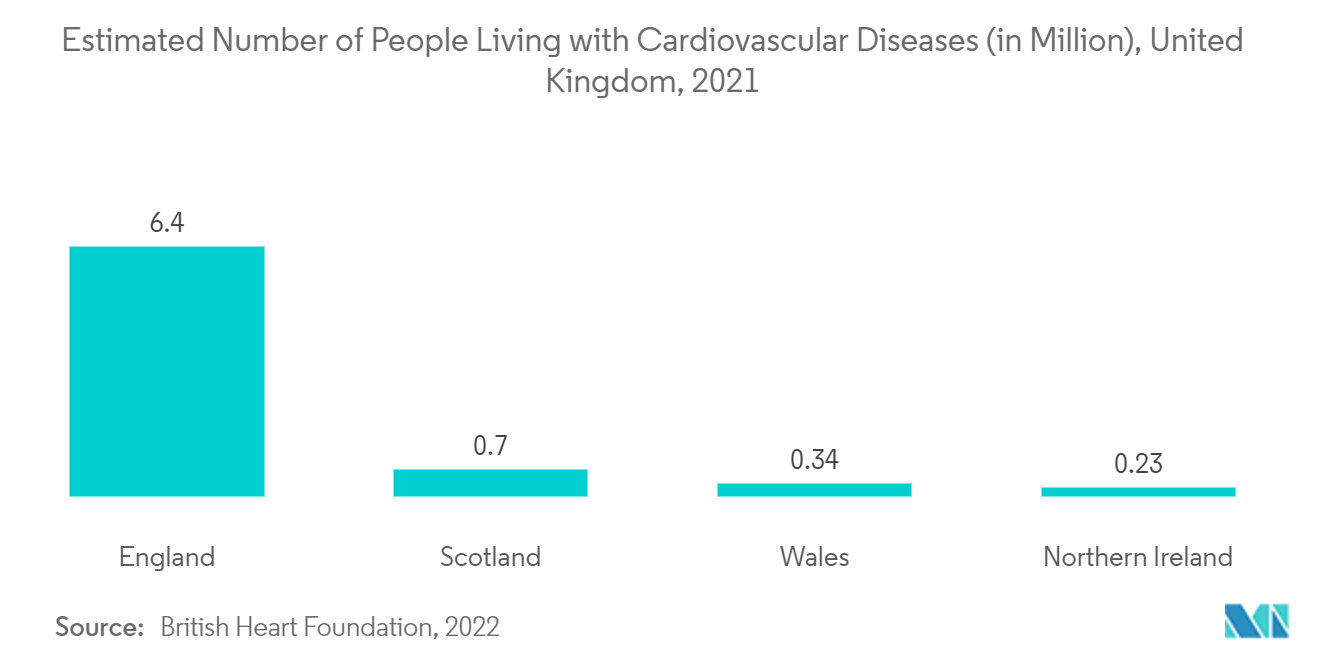
North America is Expected to Hold a Significant Share in the Market during the Forecast Period
North America is expected to hold significant growth during the robotic-assisted surgery systems market throughout the forecast period owing to the high burden of chronic diseases, technological advancements in robotic-assisted surgery systems, and launches by market players.
The high burden of chronic diseases in the region drives the demand for robotic-assisted surgeries which is expected to propel the market growth. For instance, according to 2022 statistics published by American Heart Association, the prevalence rate of heart failure in the United States was 6 million, which is 1.8% of the total population, in 2021. Also, according to 2022 statistics published by American Heart Association, the prevalence rate of heart failure in Canada was between 1.5% to 1.9% in 2021. Thus, the high burden of cases of heart failure in the country is expected to increase the demand for advanced robotic-assisted surgery systems for better treatment which is further expected to boost the growth of the market over the forecast period.
Furthermore, the increasing acceptance of MIS procedures over traditional surgeries is also driving the growth of the studied market. For instance, in December 2022, Medtronic plc reported the first patient enrolled in the expansion of the United States clinical trial for the Hugo robotic-assisted surgery (RAS) system. The robotic-assisted prostatectomy procedure was performed by Dr. Michael R. Abern at Duke University Hospital in Durham, N.C. Thus, such expansion of MIS is increasing the demand for this procedure in the region.
The strategic initiatives by market players such as product launches, approval, and partnerships to expand the robotic-assisted surgery systems in the region are expected to propel the market growth. For instance, in October 2021, Medtronic Canada ULC commercially launched the Mazor X System in Canada for robotic-guided spine surgery. Also, in March 2021, Asensus Surgical received approval from the FDA for its Senhance Surgical System, which is a digital laparoscopic platform to provide surgical assurance through haptic feedback, eye-tracking camera control, and 3D visualization. Thus, the launch of new products in the region is anticipated to drive the market significantly.
Therefore, owing to the above-mentioned factors such as the high burden of cardiovascular diseases, rising product approvals, and launches by market players, the growth of the studied market is anticipated in the North America Region.
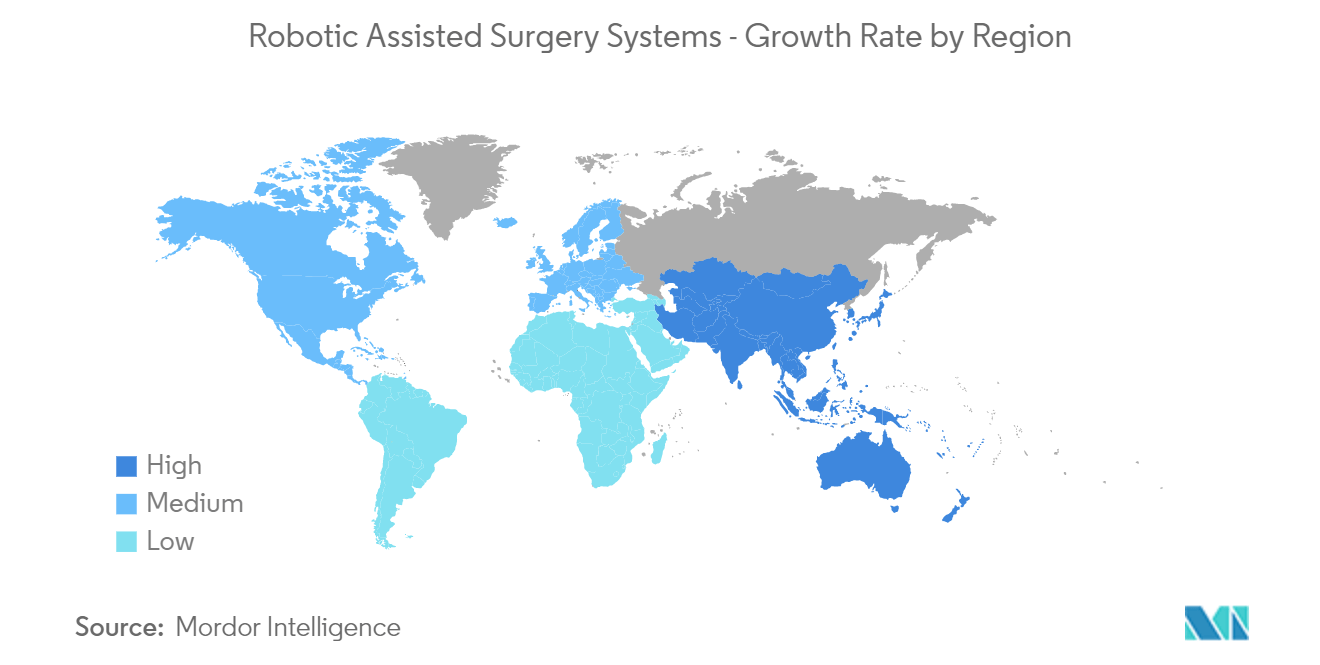
Robot-assisted Surgical Systems Industry Overview
The robotic-assisted surgery systems market is fragmented in nature due to the presence of several international and local market players. Some key market players are Intuitive Surgical Inc., Stryker Corporation, Johnson & Johnson Inc, SRI International Inc., Accuray Incorporated, Renishaw PLC, Medtronic PLC, Brainlab, Smith & Nephew PLC, Globus Medical, Zimmer Biomet.
Robot-assisted Surgical Systems Market Leaders
-
Intuitive Surgical Inc.
-
Globus Medical Inc.
-
Medtronic
-
Brainlab
-
Stryker Corporation
*Disclaimer: Major Players sorted in no particular order
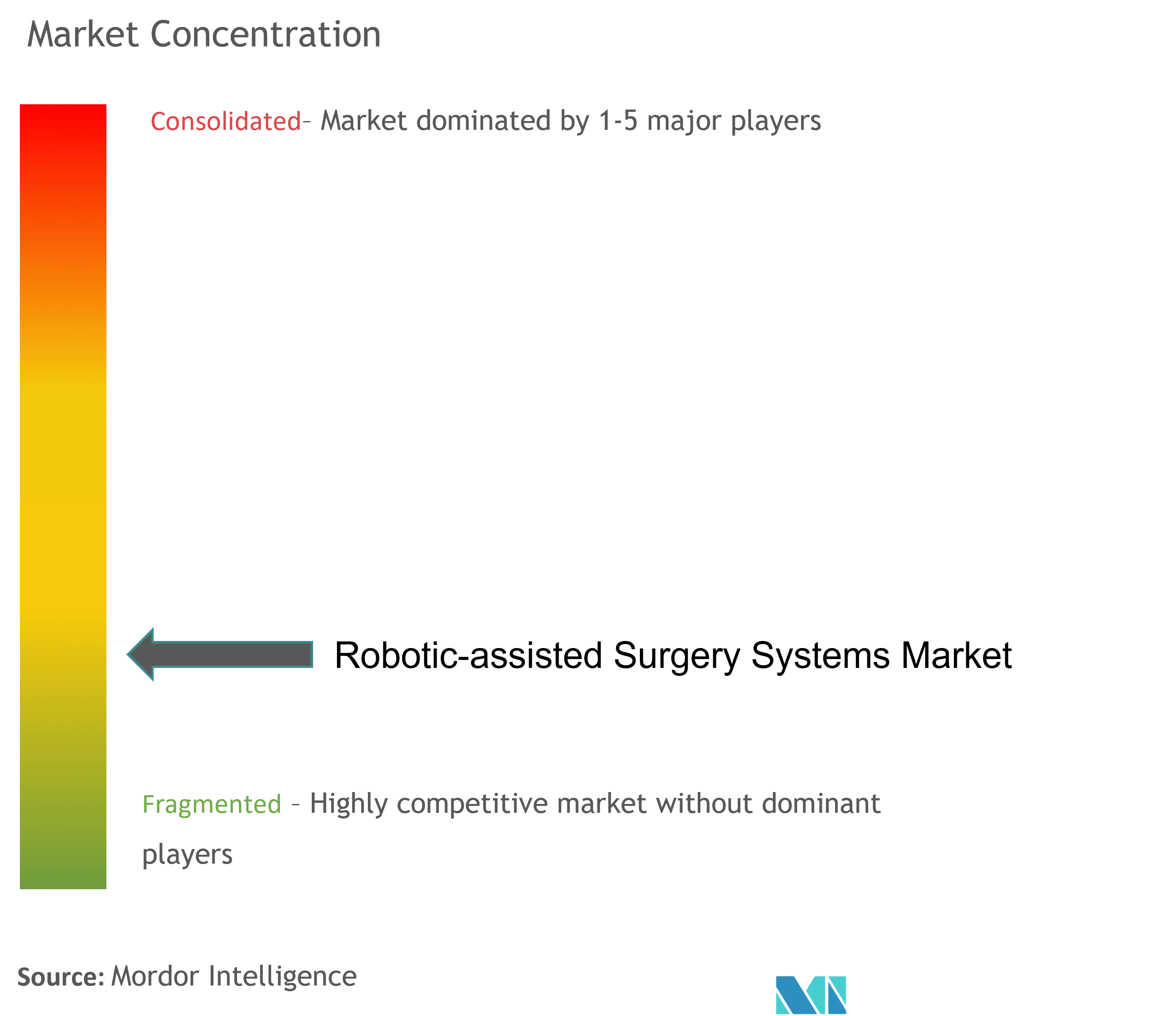
Robot-assisted Surgical Systems Market News
- In November 2022, MedTech start-up SS Innovations acquired Avra Medical Robotics, a United States company to expand its surgical robot devices to the global market.
- In November 2022, Accelus, a private medical technology company focused on the adoption of minimally invasive surgery (MIS) as the standard of care in the spine, received U.S. FDA approval for its Remi Robotic Navigation System software update that provides robotic-assisted pedicle screw placement for surgeons performing lumbar spine fixation.
Robot-assisted Surgical Systems Market Report - Table of Contents
1. INTRODUCTION
- 1.1 Study Assumptions and Market Definition
- 1.2 Scope of the Study
2. RESEARCH METHODOLOGY
3. EXECUTIVE SUMMARY
4. MARKET DYNAMICS
- 4.1 Market Overview
-
4.2 Market Drivers
- 4.2.1 Rising Technological Advancements and Entry of New Market Players
- 4.2.2 Increasing Cases of Chronic Diseases and Rising Preference for Minimally Invasive Surgeries
-
4.3 Market Restraints
- 4.3.1 Stringent Regulatory Processes and High Cost of Devices
-
4.4 Industry Attractiveness - Porter's Five Forces Analysis
- 4.4.1 Bargaining Power of Buyers/Consumers
- 4.4.2 Bargaining Power of Suppliers
- 4.4.3 Threat of New Entrants
- 4.4.4 Threat of Substitute Products and Services
- 4.4.5 Intensity of Competitive Rivalry
5. MARKET SEGMENTATION (Market Size by Value - USD Million)
-
5.1 By Product Type
- 5.1.1 System
- 5.1.1.1 Surgical Robot
- 5.1.1.2 Navigation System
- 5.1.2 Consumable and Accessories
- 5.1.3 Software and Services
-
5.2 By Application
- 5.2.1 Gynecological Surgery
- 5.2.2 Cardiovascular
- 5.2.3 Neurosurgery
- 5.2.4 Orthopedic Surgery
- 5.2.5 Laparoscopy
- 5.2.6 Urology
- 5.2.7 Other Applications
-
5.3 By End User
- 5.3.1 Hospitals
- 5.3.2 Ambulatory Surgery Centers
- 5.3.3 Other End Users
-
5.4 Geography
- 5.4.1 North America
- 5.4.1.1 United States
- 5.4.1.2 Canada
- 5.4.1.3 Mexico
- 5.4.2 Europe
- 5.4.2.1 Germany
- 5.4.2.2 United Kingdom
- 5.4.2.3 France
- 5.4.2.4 Italy
- 5.4.2.5 Spain
- 5.4.2.6 Rest of Europe
- 5.4.3 Asia-Pacific
- 5.4.3.1 China
- 5.4.3.2 Japan
- 5.4.3.3 India
- 5.4.3.4 Australia
- 5.4.3.5 South Korea
- 5.4.3.6 Rest of Asia-Pacific
- 5.4.4 Middle East and Africa
- 5.4.4.1 GCC
- 5.4.4.2 South Africa
- 5.4.4.3 Rest of Middle East and Africa
- 5.4.5 South America
- 5.4.5.1 Brazil
- 5.4.5.2 Argentina
- 5.4.5.3 Rest of South America
6. COMPETITIVE LANDSCAPE
-
6.1 Company Profiles
- 6.1.1 Intuitive Surgical Inc.
- 6.1.2 Stryker Corporation
- 6.1.3 Johnson & Johnson Inc.
- 6.1.4 SRI International Inc.
- 6.1.5 Accuray Incorporated
- 6.1.6 Renishaw PLC
- 6.1.7 Medtronic PLC
- 6.1.8 Smith & Nephew PLC
- 6.1.9 Brainlab
- 6.1.10 Globus Medical
- 6.1.11 Zimmer Biomet
- *List Not Exhaustive
7. MARKET OPPORTUNITIES AND FUTURE TRENDS
** Subject To AvailablityRobot-assisted Surgical Systems Industry Segmentation
As per the scope of this report, performing operative procedures with the assistance of robotic technology is referred to as robotic-assisted surgeries. A robotic system ensures precision and is used for remotely controlled, minimally invasive procedures. The current systems comprise computer-controlled electromechanical devices that work in response to controls manipulated by surgeons. The Robotic-assisted Surgery Systems Market is Segmented by Product Type (System, Consumable and Accessories, and Software and Services), Application (Gynecological Surgery, Cardiovascular, Neurosurgery, Orthopedic Surgery, Laparoscopy, Urology, and Other Applications), End User (Hospitals, Ambulatory Surgery Centers, and Other End Users), and Geography (North America, Europe, Asia-Pacific, Middle East and Africa, and Rest of the World). The market report also covers the estimated market sizes and trends for 17 countries across major regions globally. The report offers values (in USD million) for the above segments.
| By Product Type | System | Surgical Robot |
| Navigation System | ||
| By Product Type | Consumable and Accessories | |
| Software and Services | ||
| By Application | Gynecological Surgery | |
| Cardiovascular | ||
| Neurosurgery | ||
| Orthopedic Surgery | ||
| Laparoscopy | ||
| Urology | ||
| Other Applications | ||
| By End User | Hospitals | |
| Ambulatory Surgery Centers | ||
| Other End Users | ||
| Geography | North America | United States |
| Canada | ||
| Mexico | ||
| Geography | Europe | Germany |
| United Kingdom | ||
| France | ||
| Italy | ||
| Spain | ||
| Rest of Europe | ||
| Geography | Asia-Pacific | China |
| Japan | ||
| India | ||
| Australia | ||
| South Korea | ||
| Rest of Asia-Pacific | ||
| Geography | Middle East and Africa | GCC |
| South Africa | ||
| Rest of Middle East and Africa | ||
| Geography | South America | Brazil |
| Argentina | ||
| Rest of South America |
Robot-assisted Surgical Systems Market Research FAQs
How big is the Robotic Assisted Surgery Systems Market?
The Robotic Assisted Surgery Systems Market size is expected to reach USD 9.50 billion in 2024 and grow at a CAGR of 13.48% to reach USD 17.87 billion by 2029.
What is the current Robotic Assisted Surgery Systems Market size?
In 2024, the Robotic Assisted Surgery Systems Market size is expected to reach USD 9.50 billion.
Who are the key players in Robotic Assisted Surgery Systems Market?
Intuitive Surgical Inc., Globus Medical Inc., Medtronic, Brainlab and Stryker Corporation are the major companies operating in the Robotic Assisted Surgery Systems Market.
Which is the fastest growing region in Robotic Assisted Surgery Systems Market?
North America is estimated to grow at the highest CAGR over the forecast period (2024-2029).
Which region has the biggest share in Robotic Assisted Surgery Systems Market?
In 2024, the Asia Pacific accounts for the largest market share in Robotic Assisted Surgery Systems Market.
What years does this Robotic Assisted Surgery Systems Market cover, and what was the market size in 2023?
In 2023, the Robotic Assisted Surgery Systems Market size was estimated at USD 8.37 billion. The report covers the Robotic Assisted Surgery Systems Market historical market size for years: 2019, 2020, 2021, 2022 and 2023. The report also forecasts the Robotic Assisted Surgery Systems Market size for years: 2024, 2025, 2026, 2027, 2028 and 2029.
Robot-assisted Surgical Systems Industry Report
The report on the Robot-assisted Surgical Systems Market provides an extensive industry analysis, offering insights into market segmentation by product type, application, end user, and geography. The market overview highlights the key segments, including systems, consumables and accessories, and software and services. The industry trends indicate significant growth in applications such as gynecological surgery, cardiovascular, neurosurgery, orthopedic surgery, laparoscopy, and urology.
The market forecast suggests a positive industry outlook, with substantial growth rate anticipated across various regions including North America, Europe, Asia-Pacific, Middle East and Africa, and the rest of the world. The market leaders in this sector are driving advancements and innovations, contributing to the overall market growth.
The industry reports provide valuable market data and market value insights, essential for understanding the market dynamics. The market research includes a detailed market review and industry statistics, which are crucial for predicting future market predictions and market segmentation trends.
The report also includes a report example and is available as a report PDF for further reference. This comprehensive industry information is beneficial for research companies and stakeholders to make informed decisions based on the market analysis and market outlook provided.



